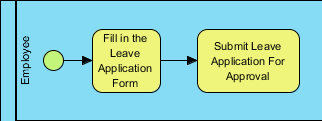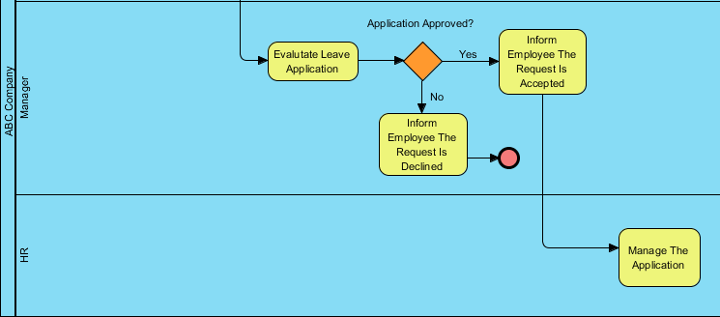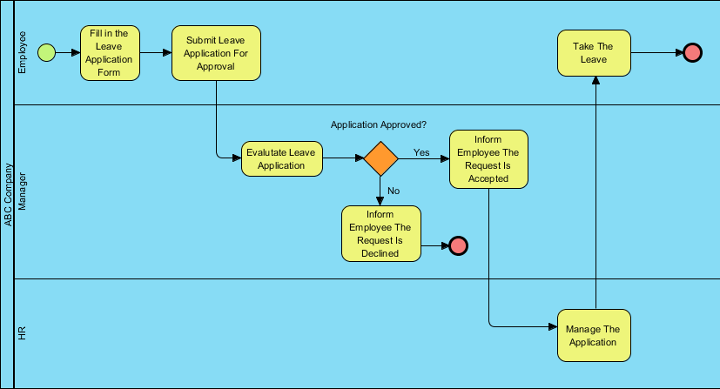Introduction
In the intricate landscape of business operations, clarity is king, and efficiency reigns supreme. Enter Business Process Model & Notation (BPMN), a robust and globally-recognized standard that transcends the limitations of traditional flow charts. Think of it as a flow chart on steroids—empowering businesses to graphically map their processes with unparalleled detail and precision.
The Power of Standardization
In the realm of process mapping, BPMN stands as the one true way. Its standardized approach provides businesses with a common language to articulate and understand their operations. This global recognition ensures that BPMN is not just a tool but a necessity for any organization aiming to draw reliable process maps.
A Clear Vision Unveiled
Mapping processes with BPMN is not merely an exercise in aesthetics; it’s a journey towards a clear and comprehensive understanding of how every cog in the business machine turns. The visual representation offered by BPMN allows stakeholders to gain insights into the intricacies of workflows, helping them comprehend the entire business ecosystem at a glance.
Time as a Precious Resource
Time is money, they say, and BPMN offers a streamlined path to savings. By mapping processes, especially with the precision of BPMN, businesses can identify and eliminate redundant tasks. This reduction in inefficiencies translates directly to time savings, allowing employees to focus on tasks that truly matter.
Memory, Precision, and Execution
In the chaos of daily operations, the risk of oversight and errors looms large. BPMN acts as a guiding light, reducing the likelihood of employees forgetting, overlooking, or incorrectly executing tasks. The visual clarity it provides serves as a constant reminder, ensuring that each step in the process is executed precisely as intended.
Beyond the Basics
While BPMN simplifies complex processes into visually intuitive maps, its capabilities extend far beyond traditional flow charts. It is a dynamic tool capable of representing complex scenarios such as information flow between teams, cloud-based data storage, and parallel departmental workflows. BPMN adapts to the evolving landscape of modern business operations, offering a comprehensive view of the interconnected processes that drive success.
Simplicity in Complexity: The Intuitive Power of BPMN
At first glance, the world of process mapping can seem like a maze of cryptic symbols and intricate diagrams. However, enter Business Process Model & Notation (BPMN), and suddenly, the complexity transforms into a dance of simplicity. One of the remarkable features of BPMN is its ability to convey the flow of processes in a way that is easily understood, even without an in-depth knowledge of the intricate symbols it employs.
The Beauty of Intuitiveness
BPMN’s strength lies not only in its precision but also in its simplicity and intuitiveness. Unlike some arcane systems that demand a decoder’s mindset to unravel, BPMN is designed to be grasped at a glance. The method employs a straightforward visual language that allows stakeholders to effortlessly follow the flow of processes without the need for extensive training or deciphering of complex symbols.
A Legacy of Evolution
BPMN is not a stagnant relic; it’s a dynamic tool that has been actively evolving since 2004. This continuous development has propelled it to the forefront of process mapping methodologies, making it the de facto standard embraced by organizations worldwide. The longevity and ongoing refinement of BPMN speak to its adaptability and relevance in an ever-changing business landscape.
Precision in Diversity
The richness of BPMN lies in its precision, and this precision is achieved through a diverse array of symbols. Each symbol is carefully crafted to cover a wide range of use cases, ensuring that every nuance of a process can be accurately represented. Whether it’s a human-centric workflow or a complex IT process, BPMN provides a visual language that speaks with clarity and accuracy.
Bridging the Human and IT Divide
One of the remarkable facets of BPMN is its versatility. It is not confined to a specific realm but extends its embrace to both human-centric and IT processes. This inclusivity allows organizations to model and communicate their internal procedures comprehensively, breaking down silos and fostering a holistic understanding of how different aspects of the business interconnect.
A Glimpse of Simplicity
At its core, a process map crafted with BPMN may seem deceptively simple. However, this simplicity is deceptive. It belies the underlying sophistication of a standardized system that encapsulates the entirety of business processes, from the mundane to the extraordinary.
BPMN is not just a flow chart; it’s a visual symphony orchestrating the movements of every element within a business. It’s the key to unlocking clarity, efficiency, and precision in the dynamic world of modern commerce. Embrace BPMN, and let your business processes dance to the rhythm of success.
Let’s delve into the intricacies of the Leave Application Process, a quintessential example that vividly demonstrates the power and clarity offered by Business Process Model & Notation (BPMN). In this visual representation, each symbol and arrow becomes a storyteller, guiding us through the journey from request initiation to process completion.
1. Initiating the Process:
- An employee, positioned in the Employee lane, triggers the process by submitting a leave request.
- The process commences with the Start Event symbol, marking the beginning of the journey.

2. Filling Out the Application:
- A solid arrow flows from the Start Event to a Task symbol, signaling that the employee must fill out a leave application form.
- This completed form is then submitted to the manager for approval.

3. Manager’s Evaluation:
- The manager, now in charge of the process, receives the leave application.
- A sequence of tasks unfolds: Submit Leave Application for Approval linked to Evaluate Leave Application on the Manager lane.
- The manager evaluates the application, leading to a decision-making point.
4. Diverging Paths:
- A Gateway symbol signifies the diverging paths based on the manager’s decision.
- If the application is declined, the process terminates with the Inform Employee the Request Is Declined task linked to an End Event.
- If approved, the manager informs the employee, and the process shifts to the HR lane for further management.

5. HR Management:
- On the HR lane, the approved application is managed, representing the continuation of the process.
- The flow leads to the final task – Take the Leave.
6. Completion of the Process:
- The End Event symbol connects to the last task, indicating the completion of the entire leave application process.
- The employee, having received approval, can now proceed to take the leave.
In essence, the BPMN visualization of the Leave Application Process serves as a comprehensive guide, allowing stakeholders to grasp the entire journey at a glance. It’s a testament to how BPMN simplifies complex workflows, providing clarity, precision, and a standardized language for efficient communication within the realm of business processes.
Conclusion
The main scope of BPMN is to empower businesses to understand their internal procedures through a graphical notation. It goes beyond mere visualization; it serves as a standardized language for organizations to communicate their processes effectively. In essence, BPMN is the bridge that transforms complex business procedures into a universally understandable visual narrative.
BPMN is not just a tool; it’s a testament to the art of simplifying complexity. Its intuitive nature, coupled with ongoing development and precision in representation, positions it as a cornerstone in the realm of process mapping. In the grand symphony of business operations, BPMN orchestrates a melody that resonates with clarity, understanding, and standardized communication.
A Robust and Versatile Tool for BPMN
Visual Paradigm stands out as a robust and comprehensive modeling tool for BPMN, making it a top choice when compared to other tools in the market. Here’s why Visual Paradigm excels in the realm of BPMN modeling:
- User-Friendly Interface:
- Visual Paradigm offers an intuitive and user-friendly interface, allowing users to easily create, edit, and visualize BPMN diagrams. The drag-and-drop functionality, coupled with a rich set of pre-built BPMN elements, makes the modeling process efficient and accessible.
- Extensive BPMN Support:
- Visual Paradigm provides extensive support for BPMN, covering the full range of BPMN 2.0 elements. This ensures that users can accurately and comprehensively model both simple and complex business processes, capturing all necessary details.
- Collaboration and Teamwork:
- Collaboration is seamless with Visual Paradigm. It supports real-time collaboration, allowing multiple users to work on the same BPMN diagram simultaneously. Comments, feedback, and changes are instantly visible, fostering effective teamwork among project stakeholders.
- Versatility and Integration:
- Visual Paradigm is not limited to BPMN; it supports a wide range of modeling notations and diagrams. This versatility is valuable for projects that require multiple modeling perspectives. Additionally, it integrates well with other development tools, enhancing its compatibility within diverse software development environments.
- Powerful Simulation and Analysis:
- Visual Paradigm goes beyond basic modeling by offering simulation and analysis features. Users can simulate business processes to identify bottlenecks, optimize workflows, and ensure the efficiency of the modeled processes.
- Documentation and Reporting:
- The tool provides robust documentation and reporting capabilities. Users can generate detailed reports and documentation directly from the BPMN diagrams, facilitating communication and knowledge sharing within the team and with stakeholders.
- Continuous Updates and Support:
- Visual Paradigm demonstrates a commitment to staying current with industry standards and user needs. Regular updates and responsive customer support ensure that users have access to the latest features and assistance when needed.
While there are other BPMN modeling tools in the market, Visual Paradigm’s combination of user-friendly design, extensive BPMN support, collaboration features, versatility, simulation capabilities, documentation support, and continuous updates make it a standout choice for businesses and teams looking to streamline their BPMN modeling processes.